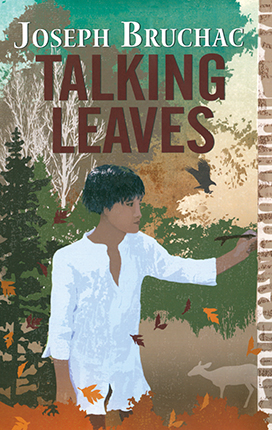| Talking leaves Author: Bruchac, Joseph | ||
| Price: $6.50 | ||
Summary:
The story of Sequoyah and the creation of the Cherokee syllabary, as told by his thirteen year old son.
| Accelerated Reader Information: Interest Level: MG Reading Level: 4.80 Points: 7.0 Quiz: 183700 | Reading Counts Information: Interest Level: 6-8 Reading Level: 4.60 Points: 13.0 Quiz: 69245 | |
Reviews:
Kirkus Reviews (05/15/16)
School Library Journal (+) (07/01/16)
Booklist (08/01/16)
The Bulletin of the Center for Children's Books (07/16)
The Hornbook (00/07/16)
Full Text Reviews:
Bulletin for the Center... - 07/01/2016 Twelve-year-old Uwohali hasn’t seen his father, Sequoyah, in six years and he’s not particularly thrilled about the man’s return. There are rumors among the Tsalagi people that Sequoyah is a practitioner of black magic and that the signs that he constantly draws are evil hexes. Sequoyah also has a new family; he’s remarried with a young daughter since Uwohali’s mother divorced him years ago. Uwohali is nonetheless drawn to his father, curious about the supposedly cursed work he does and about this unknown stepmother and half sister. Sequoyah welcomes the boy with open arms and, despite Uwohali’s misgivings about his place in Sequoyah’s life, he soon forms a deep bond with the man, listening to his stories and apprenticing in Sequoyah’s lifelong work of creating a Cherokee syllabary. Uwohali’s voice is perfectly pitched as a boy whose certainty in his identity (as his mother’s son and a Tsalagi boy) is shaken by the arrival (or return, in this case) of a new dynamic that casts what he has previously believed in a different light. Cultural and historical context is given through the interspersed Cherokee legends and Sequoyah’s war stories of his time under General Andrew Jackson. This is as much a story about fathers and sons as it is about the legendary Sequoyah’s hugely significant work, and it offers multiple points of access for history buffs or fans of family dramas. Extensive end matter includes a note about the historical Sequoyah, the Cherokee syllabary, a glossary of Cherokee words, and suggestions for further reading. KQG - Copyright 2016 The Board of Trustees of the University of Illinois.
School Library Journal - 07/01/2016 Gr 4–7—Bruchac has crafted a tale of depth and universal humanity in this fictionalized account of Sequoyah, the creator of the Cherokee syllabary, and his son, Jesse. Struggling with gossip and whispers about his father, Jesse must decide whether to embrace the vision his father has for his people or to distance himself even further from his heritage. With an authentic voice, Bruchac weaves details of Cherokee customs, cultural stories, and language without any heavy-handedness. While explaining how the Cherokee language came to be written, this work also broaches the hard lessons of growing up: What does it mean to grow separately from your friends and family? Bruchac depicts complex characters and relationships. This is a strong middle grade novel that offers a needed perspective on Cherokee history and the life of a key historical figure. VERDICT An illuminating read for middle graders; purchase anywhere historical fiction is in demand.—Beth Dobson, Weatherly Heights Elementary School, Huntsville, AL - Copyright 2016 Publishers Weekly, Library Journal and/or School Library Journal used with permission.
Booklist - 08/01/2016 A veteran storyteller pairs Sequoyah, whom he dubs a “true genius,” with a fictional son troubled by his father’s abandonment and strange behavior. Thirteen-year-old Uwohali is slow to approach his estranged father, Sequoyah, who is absorbed in creating his unique syllabary. When Uwohali finally steels himself to make contact, he receives, in addition to a warm welcome, a life-changing understanding of what his father’s invention might do to preserve their people’s culture and identity against the inroads of the Aniyonega (whites). The book’s restrained tone and deliberate pacing may make it a slog for less patient readers, but Bruchac livens the proceedings with inset folktales, low-key humor, and a heartrending reminiscence of the brutal Battle of Horseshoe Bend. Sequoyah’s life and achievements get fuller treatment in Rumford’s Sequoyah: The Cherokee Man Who Gave His People Writing (2004), but Bruchac’s portrayal of a father and son mending fences adds a more universal element. He closes with a complete chart of the syllabary’s symbols, a glossary, and notes on his sources. - Copyright 2016 Booklist.



